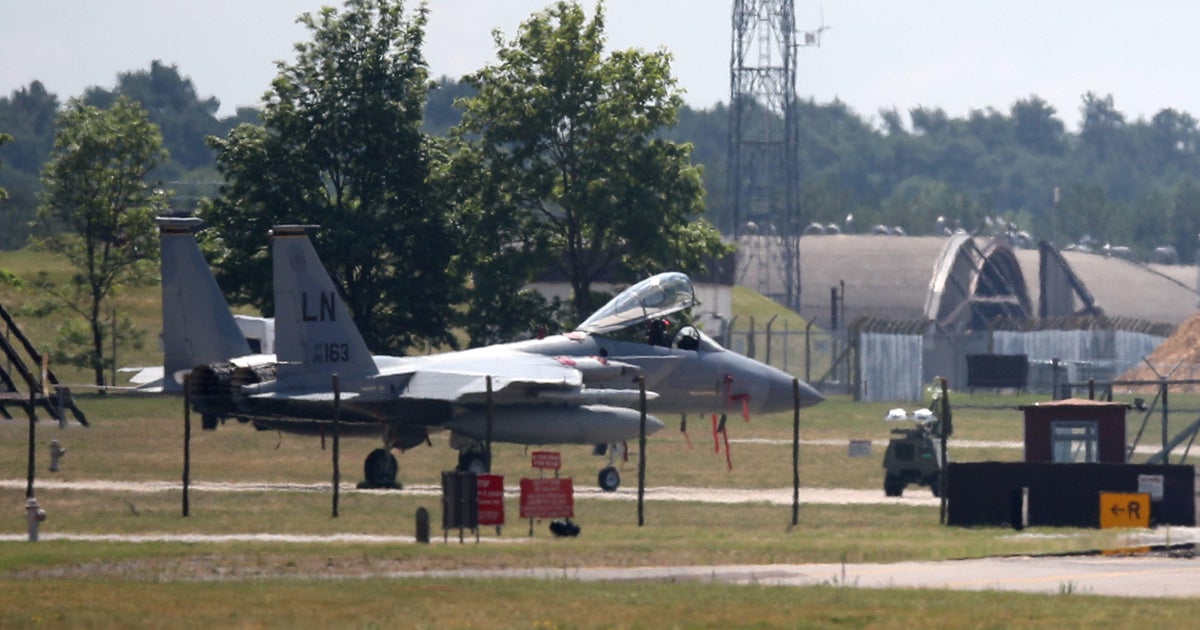CBS News
U.S. Air Force says unexplained drone sightings near U.K. military bases ongoing

The U.S. Air Force on Tuesday said that there had been more sightings of drones flying near bases used by U.S. forces in the United Kingdom, adding it had not yet identified them as hostile.
“We can confirm there were sightings yesterday (Monday) during nighttime hours and can only confirm that the number fluctuated, and varied between the bases over the night,” a USAF in Europe spokesperson said in a statement sent to Agence France-Presse by the 100th Air Refueling Wing, which is based at the Royal Air Force base in Mildenhall, eastern England.
Mildenhall is one of three bases where drones have been spotted intermittently since November 20. The other two are the nearby RAF Lakenheath and RAF Feltwell.
The USAF said in a statement Monday that “small unmanned aerial systems were spotted in the vicinity of and over Royal Air Force Lakenheath, RAF Mildenhall and RAF Feltwell between Nov. 20 and Nov. 24.”
CHRIS RADBURN/AFP/Getty
The drones ranged in sizes and configurations, it added. In Tuesday’s update, the USAF said there had been no impact to the bases’ residents or infrastructure, and that the drones “have not been identified as hostile.”
“However they are still continuously being monitored to ensure the safety and security of the installation,” it added.
“I can confirm the situation is still ongoing and our units continue to monitor the airspace and are working with host-nation authorities and mission partners to ensure the safety of base personnel, facilities, and assets,” a U.S. Air Forces in Europe spokesperson told CBS News on Tuesday.
A spokesman for the UK’s Ministry of Defence said that it took “threats seriously” and was supporting the USAF response.
While no entity or third nation has been named as a possible source of the unexplained drones, several major U.S. adversaries, including Russia and Iran, have been accused of increasing their espionage and sabotage activities in Europe this year.
U.S. fighter jets based at Lakenheath were part of the American effort to help shoot down missiles launched by Iran at Israel on April 13 — the first of two Iranian missile attacks on Israel this year.
Tension between Russia and the U.S. and Britain has also been extremely high amid the ongoing war in Ukraine, with British fighter jets scrambled only a week and a half ago to monitor a Russian reconnaissance aircraft that was flying close to U.K. airspace. That came just days after NATO jets were mobilized when Russian aircraft were spotted over the Baltic Sea and off the coast of Norway.
Charlie D’Agata and
contributed to this report.
CBS News
23andMe CEO discusses rebuilding trust

Watch CBS News
Be the first to know
Get browser notifications for breaking news, live events, and exclusive reporting.
CBS News
Some North Carolina homeowners still can’t return home after Helene landslides

Watch CBS News
Be the first to know
Get browser notifications for breaking news, live events, and exclusive reporting.
CBS News
Landslides buried parts of North Carolina after Hurricane Helene. It’s too dangerous for some homeowners to rebuild.

Katelyn Midkiff and her father, Bill, were at their kitchen table when a thunderous noise gave way to chaos. On the morning of Sept. 27, their home was consumed by a landslide in the wake of Hurricane Helene. It was one of more than 2,000 landslides in western North Carolina.
“There was a loud sound behind us,” Katelyn Midkiff said. “Then it was like we were getting thrown and pulled at the same time.”
Mud and debris from the landslide trapped them for three hours. Bill, a liver transplant patient, sustained severe injuries, including a broken neck and fractured back. He had no access to his anti-rejection medication in the pile of destruction that once was his home and land.
“The dishwasher hit me in the face,” he said. “The refrigerator would have killed me, but it’s up against the tree right now.”
The mud and debris were so thick, their neighborhood was cut off from the rest of the region. Bill and his daughter were eventually rescued by a Blackhawk helicopter.
Midkiff Family
The hill their house had stood on for 30 years was cut away by the power of the storm. The land washed down the river.
Their house was crushed against the trees and rocks, landing far downhill from where it was just hours earlier.
As the family recovers, they have learned they should not rebuild. The threat of future landslides makes it too dangerous.
The geologist’s perspective
Jennifer Bauer, a principal geologist with Appalachian Landslide Consultants, has been instrumental in mapping the landslides and assessing the risk of rebuilding. Bauer uses specialized maps to identify areas that glow in bright purple on her rugged laptop.
These “purple zones” show areas where landslides, known in geology as “debris flows,” are likely to start. The zones make up 13.3% of the mountainous counties in western North Carolina, which adds up to approximately 1,296 square miles.
CBS News
If all those areas were combined into one land mass, it would be nearly as large as the state of Rhode Island. This conclusion is based on advanced LiDAR scans taken from airplanes, satellite imagery and on-the-ground data, according to Bauer.
“It’s important for people to understand that there are lots of safe places to build and some that are not,” Bauer said as she toured impacted neighborhoods with CBS News.
The impact of climate change
Stronger and wetter storms driven by climate change are intensifying the severity and frequency of landslides.
“Since the 1980s, the hurricane record has shown a more active period in the North Atlantic Ocean,” according to NASA research. “On average, there have been more storms, stronger hurricanes, and an increase in hurricanes that rapidly intensify.”
Ed Williams, a retired water quality biologist, and his wife had hoped to build a home on their land in western North Carolina. They’re now changing their plans to build a smaller home on a different part of the property to ensure greater safety.
CBS News
“The last time a storm like this even came close to this much rain was in 1916, over 100 years ago,” Williams said. “We know now with climate change that a lot more storms are coming in from the Gulf of Mexico that we haven’t seen in the past. So those storms from the Gulf tend to be the ones that dump a lot more rain up here.”
The economic and emotional toll
For many, the financial and emotional toll of these landslides is insurmountable. Many homeowners are hoping FEMA will assist in buying them out, but it’s too early to know how much financial assistance they can expect. Some told CBS News that FEMA buyouts, while helpful, often fall far short.
In November, the Midkiff family met again with FEMA at an abandoned retail store inside a mall in Asheville, North Carolina. They filled out paperwork to have FEMA pay them fully for the home and land, but they may have to wait a very long time before they see a check that large.
CBS News
The Midkiffs, like many others, face the grim reality of abandoning their cherished homes. Often, this uncertainty leaves homeowners in limbo, unsure of where to safely rebuild.
“There are many homes below the purple zones that could be impacted by future landslides,” Bauer said.
Community resilience
Despite the devastation, the community is resilient.
“There’s something about seeing people come together, to work on rebuilding a place that means so much,” Williams said.
CBS News
As recovery efforts continue, geologists like Bauer are working tirelessly to identify safe areas for rebuilding. Still, the scars left by the landslides are a reminder of the risks of living on land that keeps moving in big rainstorms.
The landslides of 2024 mark the end of one chapter and the beginning of another for the Midkiffs, Williams and others.
“I can’t really, can’t think of anywhere else that I’d want to live,” Williams said. “So, we’re going to figure out a way to do it. There’s a lot of great places out there, but this is home for us, and this is where we want to be.”














